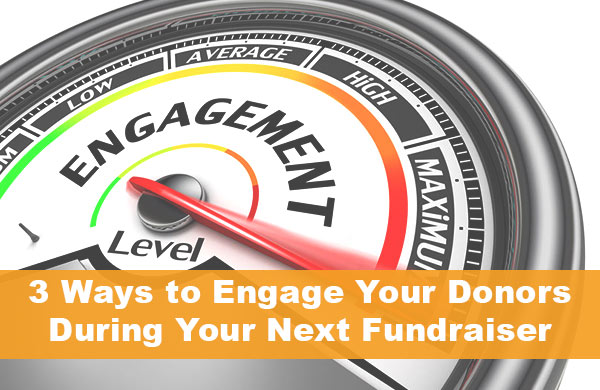Whether you’re entering your first campaign or are a seasoned fundraising professional, you likely understand that the key to successful fundraising lies in donor engagement. When a supporter is fully engaged in your campaign, they’re much more likely to donate and contribute in other ways too, like sharing your cause with their loved ones.
Donor engagement is challenging enough under normal circumstances, but when you toss in a worldwide pandemic and resulting social distancing guidelines, you have to go the extra mile to garner support. As you ramp up preparation for your next fundraising campaign, it’s vital that you put donor engagement at the forefront of your strategy.
To help, we’ve pulled together tried-and-true methods for boosting engagement based on plenty of experience in the nonprofit fundraising space. Update your strategies to account for best practices, including:
- Nurture donor segments.
- Turn to modern communication methods.
- Add an online element to your campaign.
Some organizations look at donor engagement as just another task they have to complete to secure money, rather than a way to partner with donors to make a larger impact on their mission. Avoid making this mistake by keeping these tips in mind. In turn, you’ll open the door to a two-way relationship that ultimately furthers your cause.
Ready to learn more about boosting donor engagement? Let’s dive in!
1. Nurture Donor Segments
Outreach is most effective when nonprofits take their audiences’ values and lifestyles into account. Trying to create one perfect donation appeal to send to your entire donor database will lead to generalizations and ineffective asks. Instead, strengthen communication by separating your donor population into smaller groups based on common characteristics.
This strategy, called donor segmentation, is one of a nonprofit’s most powerful strategies in its arsenal. With modern fundraising tools, there’s no reason why your organization should be implementing a one-size-fits-all approach to donor engagement.
Using the donor data you gather through various channels (such as your donation page and event registration forms), you can understand how each donor segment wants to engage with your organization so that you can cultivate much stronger relationships.
For instance, consider dividing donors into groups based on:
- How your donors would like to hear from you: What are their preferred communication channels? Regular mail, email, website, social media, etc.
- How they like to donate and how much and how often they give: This includes their preferred giving channel (e.g. online donation pages, crowdfunding, etc.) and giving type (e.g. debit/credit card, PayPal, ACH direct deposit, etc.). Are they one-time donors, major donors, recurring donors, and so on.
Rather than broadcasting the same information to everyone, your nonprofit can use its data to communicate with donors in a way that resonates with each group of supporters. You’ll be able to ask for the ideal gift amount, provide sufficient giving channels, use the correct outreach method, and re-engage donors who are at risk of lapsing.
Also read: 5 Effective Year-End Fundraising Strategies
2. Turn to Modern Communication Methods
If you want to boost engagement during your next campaign, you need to meet donors where they are and make interacting with your nonprofit as convenient as possible. And the best way to do this is with virtual outreach.
With a vast number of platforms, digital marketing opportunities are more readily available to nonprofits than ever. While you’ve likely implemented email in your marketing plans, there are more digital platforms you’ll want to consider. Let’s explore two primary communication methods for connecting with modern donors: social media and texting.
– Social Media
There’s no denying the immense impact of social media on the nonprofit fundraising space. Social media has leveled up from being a millennial pastime to being a core component of any effective marketing strategy. With more than 3.6 billion social media users worldwide, chances are that a good bit of your supporters are already on social media.
Connect with these individuals by determining which social media platforms your supporters use most often. Then, create accounts on each, and encourage users to follow your pages. From here, you can maximize engagement with proven best practices such as:
- Interact with your followers. The comment section provides a unique opportunity to communicate directly with supporters. Nurture your supporter relationships by responding to their questions and comments. By taking the time to respond, you can effectively convey that you value their opinions and care about their experiences.
- Communicate your cause through powerful imagery. Humans are motivated by compelling visuals. In fact, research shows that Facebook posts with images see 2.3 times more engagement (i.e. likes, comments, shares) and Tweets with images receive 150% more retweets than text-only posts. Because of this, you’ll want to add relevant, original images of your team’s work to your social media posts in order to encourage interaction.
Just be sure to pay attention to your audience’s reactions and adjust your messaging based on the platform. For instance, Twitter is great for shorter appeals due to the 280 character limit, whereas Facebook is perfect for longer appeals. Since Instagram is photo-based, this is the best opportunity to captivate your audience with compelling imagery that showcases your impact. Paying attention to differences such as these can go a long way in driving engagement.
– Texting
Along with being the preferred method of communication, smartphone adoptability continues to grow across the globe. Today, there are more than 275 million smartphone users in the U.S. alone, and sources project that this number will exceed 290 million in the next 4 years.
Not only can you use texting to disperse important announcements regarding your fundraisers, but you can also use it to boost participation. For instance, mobile outreach allows you to:
- Raise donations with text-to-donate. Make giving even more convenient by allowing users to give directly from their smartphones. Backed by a text-to-donate platform, you can share a keyword, which supporters text to your organization’s designated phone number. Then, they’ll receive a link that routes them to your online donation page where they can safely submit their donations.
- Increase event registration and peer-to-peer signups. When you have an upcoming event, consider texting supporters the link to your registration page to boost attendance. Running low on volunteers for your peer-to-peer fundraising campaign? This works for these campaigns too, which is a fundraising strategy that we’ll discuss more in the next section.
Take your fundraising up a notch by leveraging texting during your next campaign. Pay attention to which methods seem to yield results, whether that’s simply dispersing announcements or driving traffic to your donation form, event registration page, or peer-to-peer signup page. Supporters will appreciate the convenience of this modern communication method.
3. Add an Online Element to Your Campaign
With an increased dependency on technology, online fundraising has naturally gained momentum. Whether you’re only taking your promotion online or going entirely digital with a virtual event, the online world offers several benefits for nonprofits like yours.
Not only does going digital enhance communication with current supporters, but it also allows you to connect with new prospects. Plus, there’s very little overhead that comes with utilizing these platforms, making them very cost-effective.
Let’s explore two opportunities for adding an online component to your next campaign: a digital donation form and peer-to-peer fundraising.
– Online Donation Form
Your digital giving page serves as the hub of your online fundraising strategy. One that’s well-designed has the power to drive donor engagement and maximize donations. By that same token, a poorly-designed donation page that’s difficult to use or appears untrustworthy can drive donors away.
While Donately’s guide to optimizing donation pages features several best practices, we’ve pulled a couple of standout ones that any nonprofit can easily implement:
- Make sure it’s mobile-responsive. Empower donors to give the moment motivation strikes, even if they’re nowhere near a laptop or desktop computer. Mobile giving is rapidly gaining popularity, and a responsive donation page will automatically resize content to make filling out your form easy on any device. Otherwise, your mobile users will have to pinch, zoom in, or rotate their devices just to read your donation page, ultimately resulting in a poor user experience.
- Gather donor data. In addition to enhancing your outreach via segmentation, donor data helps you determine which fundraising efforts are falling short. Employ software that gathers information such as who your most active donors are, the effectiveness of individual fundraising campaigns, and various trends. Then, adjust your form accordingly. For instance, use your popular donation amounts to set marginally higher suggested giving amounts that encourage users to increase their donations.
Making a donation is when donor engagement is at its peak. Don’t miss out on contributions in the final stage by forcing supporters to use a poorly-designed donation form. Do everything you can to optimize your page, and you’ll create a positive experience for your online donors.
– Peer-to-Peer Fundraising
Put a twist on fundraising by putting the power into supporters’ hands with peer-to-peer fundraising. With this fundraising method, volunteers (typically current donors and other advocates) raise money on behalf of your organization. They create their own campaign pages, which they then share with their friends and family.
These campaigns tend to be successful because of a phenomenon called social proof. Simply put, social proof is the idea that people follow the actions of others so long as it appears to be the morally correct thing to do. In terms of fundraising, donors’ friends and families will support and give to a cause simply because their loved ones do.
To make the most of this fundraising opportunity, follow best practices such as:
- Share templates with participants. Just because you understand the nuances of crafting a great social media post doesn’t mean your volunteers do. Make the job much easier for your participants by sharing templates that they can customize with their personal connections to your cause.
- Recognize your top fundraisers. Nothing sparks motivation quite like a little recognition. Give shoutouts to your highest-performing participants on social media, and feature leaderboards that showcase top fundraisers. Your most impactful participants will be motivated to keep up the good work, while others will know to step up their efforts.
The best part about peer-to-peer fundraising is the sheer reach of it. You can deepen current donors’ engagement and leverage their networks to connect with new supporters all at once. Not to mention, donors will enjoy seeing the impact they have on your cause. It’s a win-win for everyone involved!
Right now, nonprofits can’t afford to miss out on donor engagement opportunities. With social distancing working against them, organizations are having to go the extra mile during the pandemic to engage their constituents and secure the necessary funds to keep their doors open.
From collecting and acting on donor data to expanding your online fundraising options, there are many opportunities for enhancing your engagement strategies. Just remember, it all depends on your unique base of supporters, so pay attention to which methods seem to motivate them to give. In turn, you’ll be able to refine your strategies and deliver an exceptional donor experience.
–
About the Author:
Andrew Berry is the head of marketing and customer success for Donately. After getting involved with nonprofits at a young age, he discovered a passion for helping organizations that are making the world a better place. Knowing how vital online fundraising has become, his goal is to help nonprofits raise more money online each year! In his spare time, you will find him cooking up dinner, playing with his dog, or cheering on Boston sports teams.


